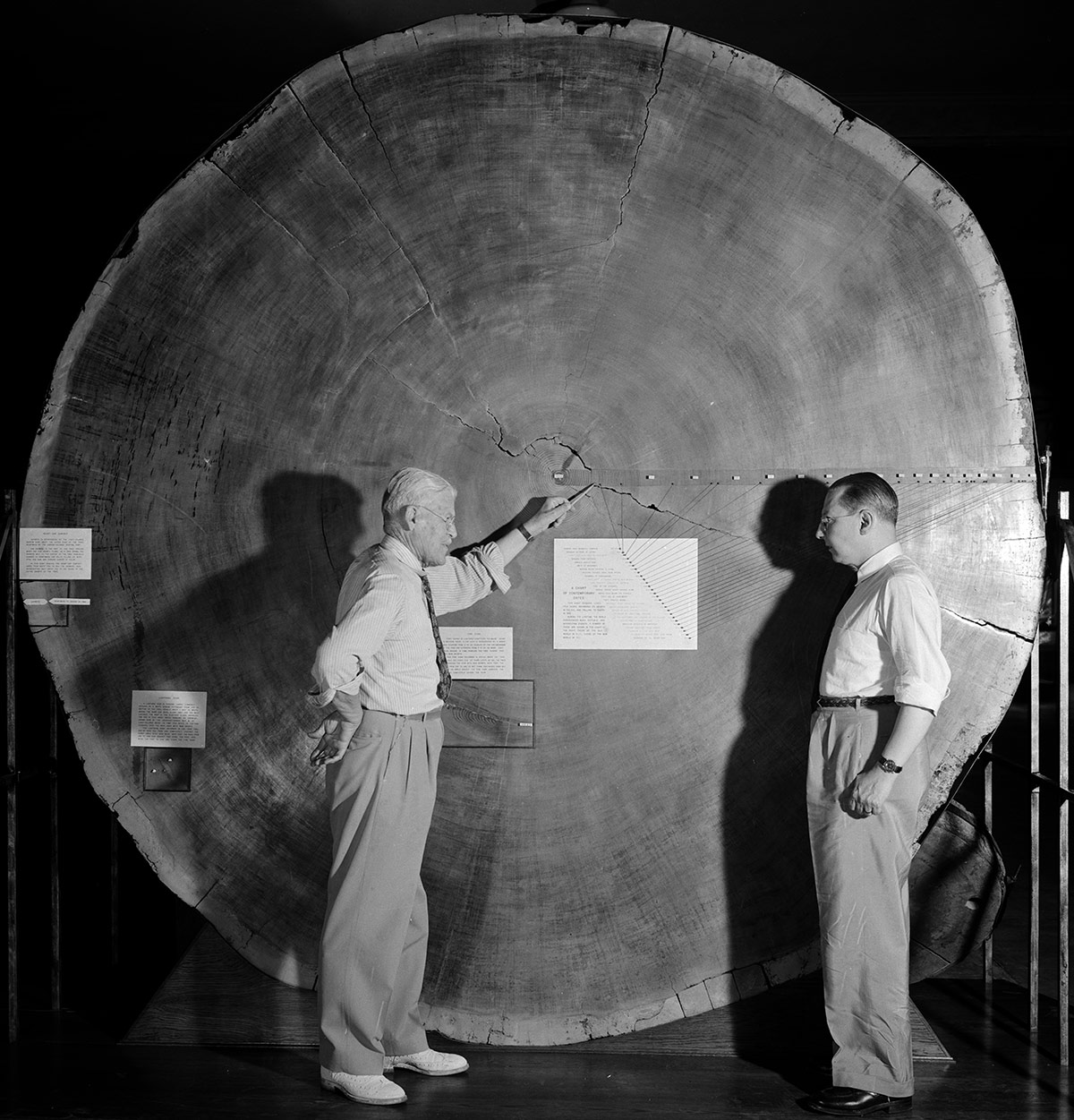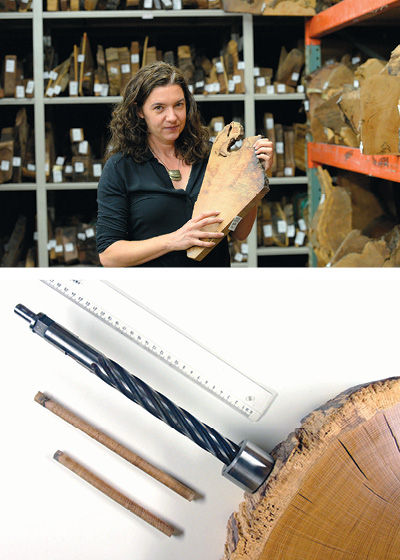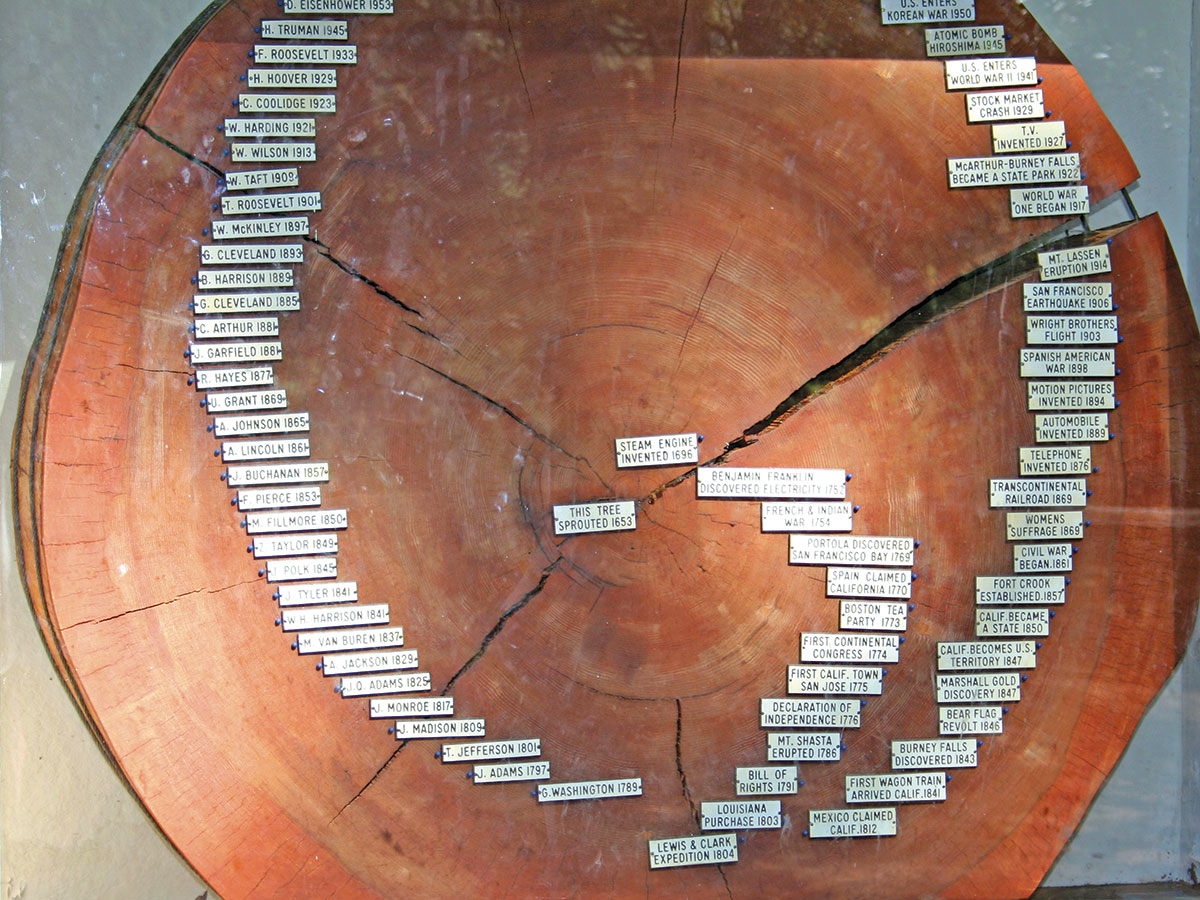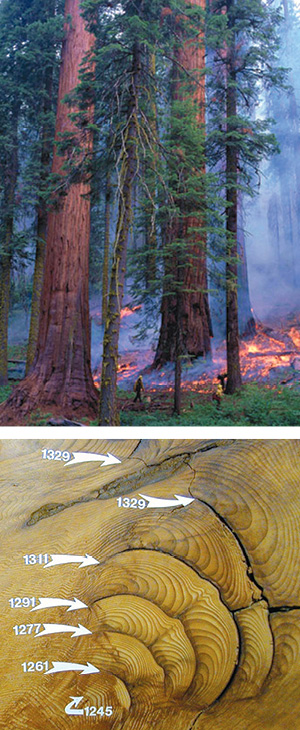Reading the Rings
Say the word “dendrochronology,” and what comes to mind? Perhaps a tree cross section showing concentric circles of annual rings, with arrows pointing to the rings from years that mark historical events. That correlation of tree growth rings to human history is dendrochronology, but there is so much more to the science of studying “tree time” (dendro + chronos) than just counting rings and calculating a tree’s age.
Dendrochronology began in 1904 when Harvard-educated astronomer Andrew Ellicott Douglass sawed rounds from ponderosa pine logs at a Flagstaff, Arizona, log yard to analyze the patterns in their growth rings. Except in the tropics, trees generally add wood each year in a regular alternation of light “earlywood” tissue bounded by a thinner ring of dark “latewood” tissue. The two comprise an annual ring. Douglass theorized that since the growth of ponderosa pines (Pinus ponderosa) in the Southwest is limited largely by available moisture, the pattern of the rings would reveal past climate patterns with narrow rings indicating drought and wide rings, wet periods. The astronomer hoped to find a connection between cycles of sunspot activity and Earth’s climate in the tree rings.
As dendrochronologist Dr. Valerie Trouet writes in her book, “Tree Story: The History of the World Written in Rings,” Douglass had arrived in Flagstaff in 1892 on a commission from Percival Lowell, a wealthy Bostonian, to choose a site for an observatory focused on Mars. Douglass ran the Lowell Observatory until 1901, when Lowell fired him after Douglass showed that the “canals” in telescope images of Mars were the result of imperfections in the images, not evidence of Martian civilization as his patron preferred to believe. (Ignoring the evidence is apparently not a new thing.)

Using a cross section of a giant sequoia (Sequoiadendron giganteum) as a massive visual aid, Douglass demonstrates how tree rings correspond to certain historical periods. PHOTO Charles Herbert/Arizona State Museum/University of Arizona
The resourceful Douglass pivoted to researching the connection between climate and sunspot activity, hence his excursion to the log yard. He was right about what the tree rings said about climate, but wrong about a correlation with sunspot cycles. Regardless, his work established a whole new field of science. In 1906, Douglass joined the faculty at the then-fledgling University of Arizona in Tucson, which is how the Laboratory of Tree-Ring Research — where Trouet works — sprouted in the tree-challenged Sonoran Desert.
Douglass cut slices from tree trunks and stumps and then counted the rings in each slice, looking for patterns in the ring widths that revealed drought/wet cycles. Those patterns allowed him to cross-date chronologies, correlating the climate story between different trees and different locations. Within a decade, Douglass had developed a cross-dated chronology of wet and dry years dating back more than four and a half centuries — the age of the oldest ponderosa pines he found.
As word spread about Douglass’ dendrochronology work, anthropologists interested in precisely dating the construction of prehistoric ruins at Mesa Verde, Chaco Canyon and other sites contacted him with the idea that those chronologies could date the ponderosa pine roof beams in these structures. Well-preserved by the arid climate, the beams did yield readable rings, but they didn’t connect to his existing tree-ring chronology: They were too old.
Finally, in 1927, Douglass sampled a beam from a ruin near Show Low, Arizona, with a ring pattern whose youngest rings overlapped the modern series and oldest rings linked to the older roof beams. That allowed him to precisely date dozens of archeological sites — and extended the Southwest’s tree-ring climate record back to about A.D. 900.
Now and Then
These days, dendrochronologists usually forgo chain saws and sample trees with a tool called an increment borer: slender, threaded tubes ranging from 16 inches to 3 feet long. Screwing the threaded end into the tree requires significant muscle power; backing the borer out requires care to preserve the core, a wood cylinder about the diameter of a pencil containing a record of the tree’s growth from youngest rings just under the bark to oldest at the middle.
If the tree is healthy, researchers say, coring doesn’t injure it: Sap seals the bore-hole just as it does when a woodpecker drills into the trunk. “It’s a bit like drawing blood,” comments Trouet. “You pierce the skin and then pull out the sample.” Wildflower Center Arboretum Manager Phillip Schulze points out that in humid climates such as Austin’s, the bore-hole might allow fungus to enter the tree. Due to that risk, and the fact that many of the Center’s oldest trees are oaks with rotten cores, he dates the trees by counting the rings of large branches he prunes and extrapolating from there.
What makes tree-ring research so compelling is that trees are sensitive recorders of their environment. Dr. Park Williams, professor at the Lamont-Doherty Earth Observatory of Columbia University, calls them “in situ soil-moisture sensors.” Their growth rings also record damage from violent storms such as hurricanes, dramatic annual temperature fluctuations, inundation by tsunamis, and other catastrophic events. The environmental stories that researchers read in those rings deepens our understanding of human history.

TOP Dr. Valerie Trouet in the Laboratory of Tree-Ring Research PHOTO Geoff Notkin BOTTOM An increment borer and two cores. PHOTO Hannes Grobe/Creative Commons (CC BY-SA 2.5)
For example, Trouet says that European tree rings reveal three centuries of climate instability (exceptionally warm and dry periods alternating with cold and wet ones) between A.D. 250 and 550, shedding light on the breakup of the Roman Empire. The sustained climate fluctuations, she points out, would have depressed farming and food supplies, contributing to the empire’s collapse. In Central Asia, the tree-ring story shows that the period between 1211 and 1225, when Genghis Khan and his cavalry conquered Asia, was wetter than any time in the previous 1,000 years. That bounty of precipitation likely gave Khan’s cavalry a boost by dramatically increasing the productivity of the region’s semiarid grasslands.
Looking at the past also helps us prepare for the future. Some of what researchers are seeing pertains directly to gardens and gardening.Williams points to evidence of four megadroughts in the Southwest during the 900s, 1200s and 1500s, periods he characterizes as having “phenomenally dry conditions lasting for decades or even centuries, unlike anything we have experienced recently.” That is, until the extremely dry years from 2000 through 2018.
Williams compared the pattern of soil-moisture loss revealed in the tree-ring data for those recent dry years to the onset of the medieval megadroughts. His analysis showed a troubling similarity: The modern dry period shows a sharp decline in soil moisture very similar to the first 19 years of each medieval megadrought. In fact, the drying trend of the recent years is more severe than all but one of the megadroughts, Williams says.
If, as the tree rings suggest, the region is heading into another megadrought, that means serious impacts for the Southwest’s perennially short water supplies. And it also means rethinking gardens and landscapes, including planting more drought-hardy native plants.

Another hefty cross section (once on display at McArthur-Burney Falls Memorial State Park in Burney, California) was annotated with presidential terms and historical events, such as the invention of the telephone. PHOTO Mark and Audrey Gibson/Alamy
Jet-setting
New research also shows that the density of the wood in tree rings connects the movements of Earth’s jet streams, our planet’s high-altitude winds, to weather far below. The link? Air temperature during the growing season: The jet streams, those waving rivers of wind powered by Earth’s rotation and flowing 5 to 9 miles above our planet’s surface where jets fly, separate cold Arctic air from warm tropical air. Their position affects seasonal air temperatures, which in turn determines wood density of growing trees.
Trouet and her colleagues tested this by trekking to remote forests in the Balkans and Scotland, increment borers in hand, to sample the oldest trees in each area. After reconstructing a thousand-year tree-ring chronology, they measured wood density in the rings by calculating the thickness of the cell walls to see if it correlated with the opposing poles of summer temperatures in the region.
The North Atlantic jet stream, the one Trouet and her colleagues focused on, is normally located at around 52 degrees north latitude in summer (just north of Scotland and Scandinavia). When it oscillates farther north, tropical air follows, bringing anomalously warm summers to Scotland, while the Balkans and Eastern Europe shiver. When the North Atlantic jet strays south, the effect reverses: Scotland turns cold, while the Balkans swelter. The researchers’ wood density measurements tracked those temperature patterns and thus the movement of the jet streams.
In North America, a similar opposing-poles effect created by the jet stream’s waving path causes drought to parch California and the Southwest, while the eastern half of the continent freezes. Past fluctuations in the jet streams chronicled in the tree-ring record may help us understand what climate change could bring — and which regions might be sizzling in heat waves and apocalyptic forest fires, or buried in “snowmageddons.”
Like a Hurricane
Dendrochronology, the field that began when an astronomer turned to studying tree rings, is still strongly interdisciplinary. Those roots show in a study that combined tree-ring records with shipwrecks and pirate activity to trace the frequency of Caribbean hurricanes before written records began. The project sprouted when Trouet and two other researchers, paleotempestologist Dr. Grant Harley and dendroarcheologist Dr. Marta Domínguez-Delmás, confabbed after a conference.
As Harley described correlating ring patterns in slash pine trees (Pinus elliottii) on Florida’s Big Pine Key to hurricane occurrence over 350 years, and Domínguez Delmás talked about wreck-diving in the Caribbean to retrieve preserved timbers for dating, an idea formed: Since hurricanes were the most common cause of shipwrecks in the area before steam engines were invented, modeling the frequency of shipwrecks might allow them to extend the tree-ring record and “see” earlier hurricane patterns.
Their analysis included only shipwrecks that occurred during hurricane season and not those attributable to other factors: war, mechanical failure or navigation errors. Correlating that data with the tree-ring chronology yielded a model of hurricane activity stretching back to 1495 — except for a puzzling lull in both shipwrecks and hurricane activity between 1645 and 1715. Staring at that anomaly, Trouet realized the gap almost exactly overlapped the Maunder Minimum, a decades-long period known for low sunspot activity and thus less solar radiation. Which meant cooler sea-surface temperatures, fewer hurricanes and fewer shipwrecks.
The connection to pirates came when a historian colleague pointed out that the gap in hurricane activity correlated with the Golden Age of Piracy, from 1650 to 1720, when pirates such as Anne Bonny and Blackbeard roamed the Caribbean. Without hurricanes, they could freely plunder treasure-laden Spanish ships returning from the Americas, an unexpected connection revealed by cross-disciplinary research.

TOP Tree-ring research on past wildfire patterns can direct how often to conduct prescribed burns such as this one in Sequoia National Park. PHOTO Tom Swetnam BOTTOM A cross section of giant sequoia shows both tree rings and fire scars. PHOTO Laboratory of Tree-Ring Research at the University of Arizona
Water Ways
“That’s how science works,” says geologist Dr. Claudia I. Mora, dean of the College of Geosciences at The University of Texas at Austin. “You stumble into something and sometimes it works, sometimes not. But you learn either way.” Mora specializes in detecting and analyzing the ratios of stable isotopes — forms of an element with different atomic weights. These “chemical fingerprints” illuminate the environment in which natural matter such as shells, stalactites, soil layers or tree rings form. Mora had never worked with dendrochronology until a geographer colleague wondered over coffee if isotopes in the wood of his southern tree-core samples would reveal information about the environment when that wood formed.
Intrigued, Mora decided to focus on two isotopes of oxygen, O-16 and O-18. She reasoned that the ratio of these two would reflect the origin of the water the tree was drinking. “Tropical cyclones will recirculate water over and over again [evaporating and recondensing it], and over time it becomes richer in O-16,” says Mora. “Drought has the opposite effect: As the water in the soil evaporates, the O-16 goes with the vapor, so the water in the soil becomes richer in O-18.”
Because water molecules are incorporated in cellulose, the main structural component of wood, the ratio of oxygen isotopes would be recorded in tree rings. Mora used scalpels to painstakingly shave the thinnest of samples from the darker latewood of each ring, which forms when hurricanes would occur. She then chemically stripped out all but the cellulose to look for its oxygen isotopes. The ratios of O-16 to O-18 showed where the trees obtained their water in different years and different seasons, yielding a more detailed climate story than simply reading the patterns of the rings.
What other questions can dendrochronology answer? The Wildflower Center’s Schulze points to an arborist colleague who is using tree-ring dating to authenticate marker trees shaped by Comanches; validation could help document and preserve these Texas cultural resources. Schulze also wonders about fire and fire history in Central Texas, noting that tree-ring research has illuminated fire patterns and frequency in many parts of the West. “Bald cypress [Taxodium distichum], some of Texas’ oldest trees, can tolerate a fire and have fire scars,” he says. “I’d be interested in what we can learn from them.”
Tree rings clearly have a lot to teach us, whether about historical events, climate patterns, where plants’ drinking water comes from, fire, or what our gardens may face in years to come. As these ingenious scholars have proven, the more carefully we read the rings, the more we learn about our planet’s past and our potential future.
Susan J. Tweit is an award-winning writer and plant ecologist. Her thirteen books include the forthcoming memoir “Bless the Birds: Living with Love in a Time of Dying,” hailed by author Craig Childs as a story that left him “awed and shaken.” She lives in and writes from the high-desert West.

